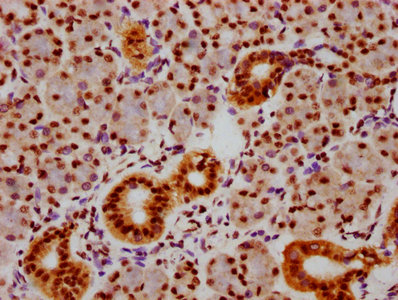Alternative Names
DKFZp781C1895 antibody; DKFZp781O1323 antibody; Dwfc antibody; hSmad5 antibody; JV5 1 antibody; JV5-1 antibody; MAD homolog 5 antibody; MAD, mothers against decapentaplegic homolog 5 antibody; MADH 5 antibody; MADH5 antibody; Mothers against decapentaplegic homolog 5 antibody; mothers against decapentaplegic, drosophila, homolog of, 5 antibody; Mothers against DPP homolog 5 antibody; MusMLP antibody; SMA and MAD related protein 5 antibody; SMAD 5 antibody; SMAD family member 5 antibody; SMAD, mothers against DPP homolog 5 antibody; Smad5 antibody; SMAD5_HUMAN antibody
Immunogen
A synthesized peptide derived from Human Phospho-SMAD5 (S463+S465)
Immunogen Species
Homo sapiens (Human)
Purification Method
Affinity-chromatography
Concentration
It differs from different batches. Please contact us to confirm it.
Buffer
Rabbit IgG in 10mM phosphate buffered saline , pH 7.4, 150mM sodium chloride, 0.05% BSA, 0.02% sodium azide and 50% glycerol.
Tested Applications
ELISA, IHC
Recommended Dilution
| Application |
Recommended Dilution |
| IHC |
1:50-1:200 |
Storage
Upon receipt, store at -20°C or -80°C. Avoid repeated freeze.
Lead Time
Basically, we can dispatch the products out in 1-3 working days after receiving your orders. Delivery time maybe differs from different purchasing way or location, please kindly consult your local distributors for specific delivery time.
Description
This phosphorylated SMAD5 antibody CSB-RA859108A463phHU is a recombinant monoclonal antibody produced from the expression of the plasmids that were integrated by the phospho-SMAD5 (S463+S465) monoclonal antibody DNA sequence in cell lines. The phospho-SMAD5 (S463+S465) monoclonal antibody was generated from splenocytes isolated from the animals that were immunized with the human phospho-SMAD5 (S463+S465). The phospho-SMAD5 (S463+S465) recombinant antibody is a rabbit IgG antibody. It underwent purification using the affinity-chromatography method. It can detect the human phospho-SMAD5 (S463+S465). And it is suitable for ELISA and IHC analyses.
SMAD5 is a receptor-activated Smad that serves as an intracellular signal transducer for the transforming growth factor (TGF) superfamily. SMAD5 regulates cytoplasmic metabolic machinery and works as an intracellular pH messenger to maintain cell bioenergetic balance. SMAD5 is a negative regulator of embryonic hematopoiesis in a haploinsufficiency form, according to a recent study by Bing Liu et al., which helps to understand the cytogenetic mechanism by which SMAD5 serves as a leukemia suppressor.
Usage
For Research Use Only. Not for use in diagnostic or therapeutic procedures.






